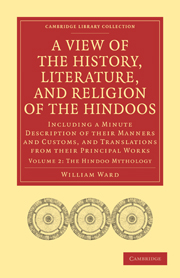 A View of the History, Literature, and Religion of the Hindoos
A View of the History, Literature, and Religion of the Hindoos Book contents
- Frontmatter
- Contents
- BOOK II OF THE TEMPLES, IMAGES, PRIESTS, AND TEMPLE WORSHIP OF THE HINDOOS
- BOOK III OF THE STATED PERIODS OF WORSHIP, AND VARIOUS DUTIES AND CEREMONIES
- BOOK V DOCTRINES OF THE HINDOO RELIGION
- CHAP. I OF THE TRANSMIGRATION OF SOULS
- CHAP. II JUDGMENT OF MEN AFTER DEATH
- CHAP. III OF FUTURE HAPPINESS
- CHAP. IV OF FUTURE PUNISHMENTS
- BOOK VI
- BOOK VII HINDOO RELIGIOUS SECTS
- CONCLUDING REMARKS
- APPENDIX: Scripture Illustrations from Hindoo Manners and Customs
CHAP. II - JUDGMENT OF MEN AFTER DEATH
Published online by Cambridge University Press: 29 August 2010
- Frontmatter
- Contents
- BOOK II OF THE TEMPLES, IMAGES, PRIESTS, AND TEMPLE WORSHIP OF THE HINDOOS
- BOOK III OF THE STATED PERIODS OF WORSHIP, AND VARIOUS DUTIES AND CEREMONIES
- BOOK V DOCTRINES OF THE HINDOO RELIGION
- CHAP. I OF THE TRANSMIGRATION OF SOULS
- CHAP. II JUDGMENT OF MEN AFTER DEATH
- CHAP. III OF FUTURE HAPPINESS
- CHAP. IV OF FUTURE PUNISHMENTS
- BOOK VI
- BOOK VII HINDOO RELIGIOUS SECTS
- CONCLUDING REMARKS
- APPENDIX: Scripture Illustrations from Hindoo Manners and Customs
Summary
At the extremity of the earth southwards, floating on the waters, is Sŭngyŭmŭnēē, the residence of Yŭmŭ, the judge of the dead, and of his recorder Chitrŭ-gooptŭ, and his messengers. Yŭmŭ has four arms, is of a dark colour, with eyes like the petal of the water-lily; in his hands he holds a shell, a discus, a club, and a lotus; he rides on Gŭroorŭ; wears a golden poita, and pearl ear-rings; and has a crown on his head, and a garland of flowers round his neck. Chitrŭ-gooptŭ, the recorder, and Yŭmŭ's attendants, appear in the most pleasing forms.
Those who perform works of merit are led to Yŭmŭ's palace along the most excellent roads, in some parts of which the heavenly courtezans are seen dancing or singing; and gods, gŭndhŭrvŭs, &c. are heard chanting the praises of other gods; in others showers of flowers are falling from heaven; in other parts are houses containing cooling water, and excellent food; pools of water covered with nymphœas; and trees, affording fragrance by their blossoms and shade by their leaves. The gods are seen to pass on horses or elephants, with white umbrellas carried over them; or in palanqueens or chariots, fanned with the chamŭrŭs of the gods: while the dévŭrshees are chanting their praises as they pass along.
- Type
- Chapter
- Information
- A View of the History, Literature, and Religion of the HindoosIncluding a Minute Description of their Manners and Customs, and Translations from their Principal Works, pp. 166 - 169Publisher: Cambridge University PressPrint publication year: 2010First published in: 1817
